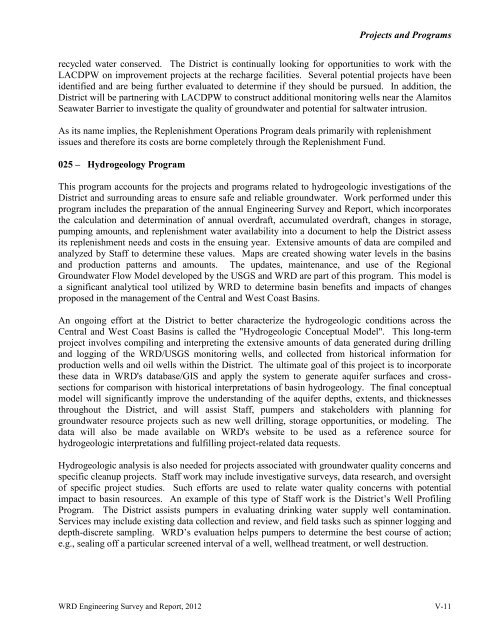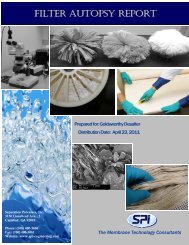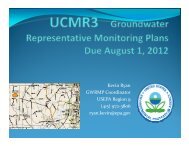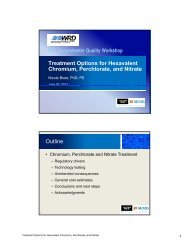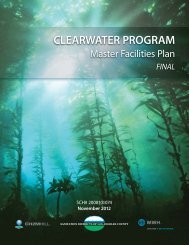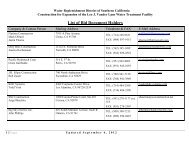Download pdf - Water Replenishment District of Southern California
Download pdf - Water Replenishment District of Southern California
Download pdf - Water Replenishment District of Southern California
You also want an ePaper? Increase the reach of your titles
YUMPU automatically turns print PDFs into web optimized ePapers that Google loves.
Projects and Programs<br />
recycled water conserved. The <strong>District</strong> is continually looking for opportunities to work with the<br />
LACDPW on improvement projects at the recharge facilities. Several potential projects have been<br />
identified and are being further evaluated to determine if they should be pursued. In addition, the<br />
<strong>District</strong> will be partnering with LACDPW to construct additional monitoring wells near the Alamitos<br />
Seawater Barrier to investigate the quality <strong>of</strong> groundwater and potential for saltwater intrusion.<br />
As its name implies, the <strong>Replenishment</strong> Operations Program deals primarily with replenishment<br />
issues and therefore its costs are borne completely through the <strong>Replenishment</strong> Fund.<br />
025 – Hydrogeology Program<br />
This program accounts for the projects and programs related to hydrogeologic investigations <strong>of</strong> the<br />
<strong>District</strong> and surrounding areas to ensure safe and reliable groundwater. Work performed under this<br />
program includes the preparation <strong>of</strong> the annual Engineering Survey and Report, which incorporates<br />
the calculation and determination <strong>of</strong> annual overdraft, accumulated overdraft, changes in storage,<br />
pumping amounts, and replenishment water availability into a document to help the <strong>District</strong> assess<br />
its replenishment needs and costs in the ensuing year. Extensive amounts <strong>of</strong> data are compiled and<br />
analyzed by Staff to determine these values. Maps are created showing water levels in the basins<br />
and production patterns and amounts. The updates, maintenance, and use <strong>of</strong> the Regional<br />
Groundwater Flow Model developed by the USGS and WRD are part <strong>of</strong> this program. This model is<br />
a significant analytical tool utilized by WRD to determine basin benefits and impacts <strong>of</strong> changes<br />
proposed in the management <strong>of</strong> the Central and West Coast Basins.<br />
An ongoing effort at the <strong>District</strong> to better characterize the hydrogeologic conditions across the<br />
Central and West Coast Basins is called the "Hydrogeologic Conceptual Model". This long-term<br />
project involves compiling and interpreting the extensive amounts <strong>of</strong> data generated during drilling<br />
and logging <strong>of</strong> the WRD/USGS monitoring wells, and collected from historical information for<br />
production wells and oil wells within the <strong>District</strong>. The ultimate goal <strong>of</strong> this project is to incorporate<br />
these data in WRD's database/GIS and apply the system to generate aquifer surfaces and crosssections<br />
for comparison with historical interpretations <strong>of</strong> basin hydrogeology. The final conceptual<br />
model will significantly improve the understanding <strong>of</strong> the aquifer depths, extents, and thicknesses<br />
throughout the <strong>District</strong>, and will assist Staff, pumpers and stakeholders with planning for<br />
groundwater resource projects such as new well drilling, storage opportunities, or modeling. The<br />
data will also be made available on WRD's website to be used as a reference source for<br />
hydrogeologic interpretations and fulfilling project-related data requests.<br />
Hydrogeologic analysis is also needed for projects associated with groundwater quality concerns and<br />
specific cleanup projects. Staff work may include investigative surveys, data research, and oversight<br />
<strong>of</strong> specific project studies. Such efforts are used to relate water quality concerns with potential<br />
impact to basin resources. An example <strong>of</strong> this type <strong>of</strong> Staff work is the <strong>District</strong>’s Well Pr<strong>of</strong>iling<br />
Program. The <strong>District</strong> assists pumpers in evaluating drinking water supply well contamination.<br />
Services may include existing data collection and review, and field tasks such as spinner logging and<br />
depth-discrete sampling. WRD’s evaluation helps pumpers to determine the best course <strong>of</strong> action;<br />
e.g., sealing <strong>of</strong>f a particular screened interval <strong>of</strong> a well, wellhead treatment, or well destruction.<br />
WRD Engineering Survey and Report, 2012 V-11


